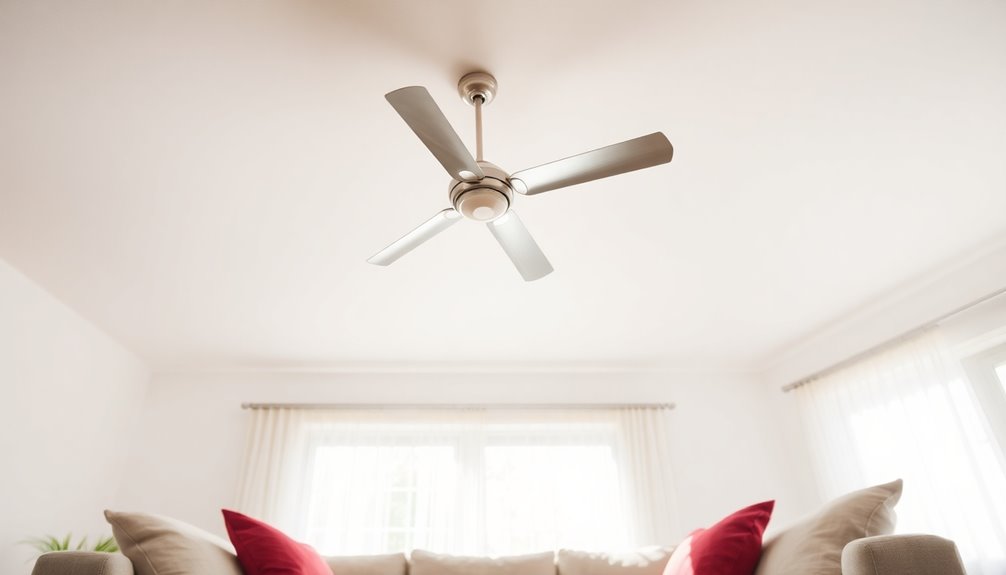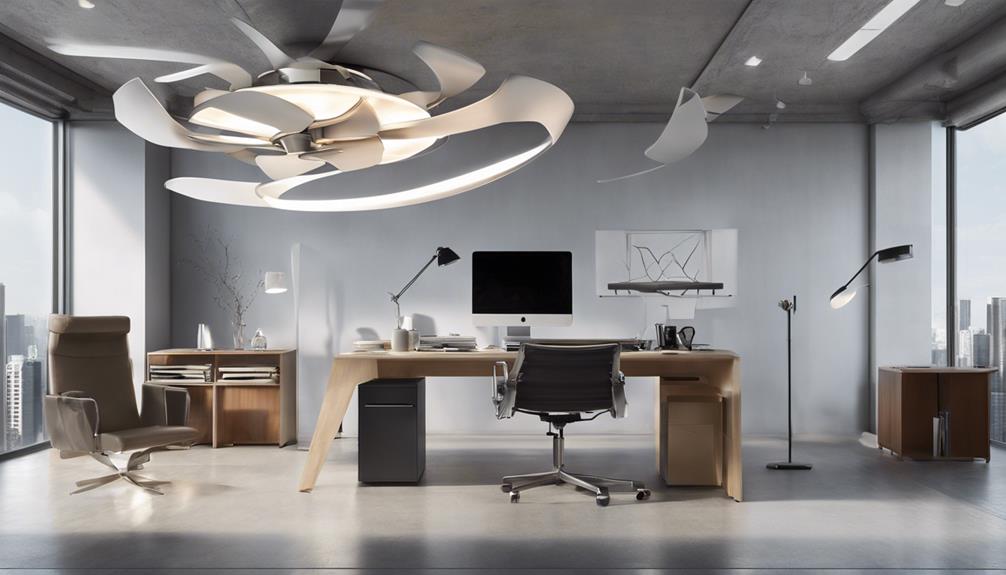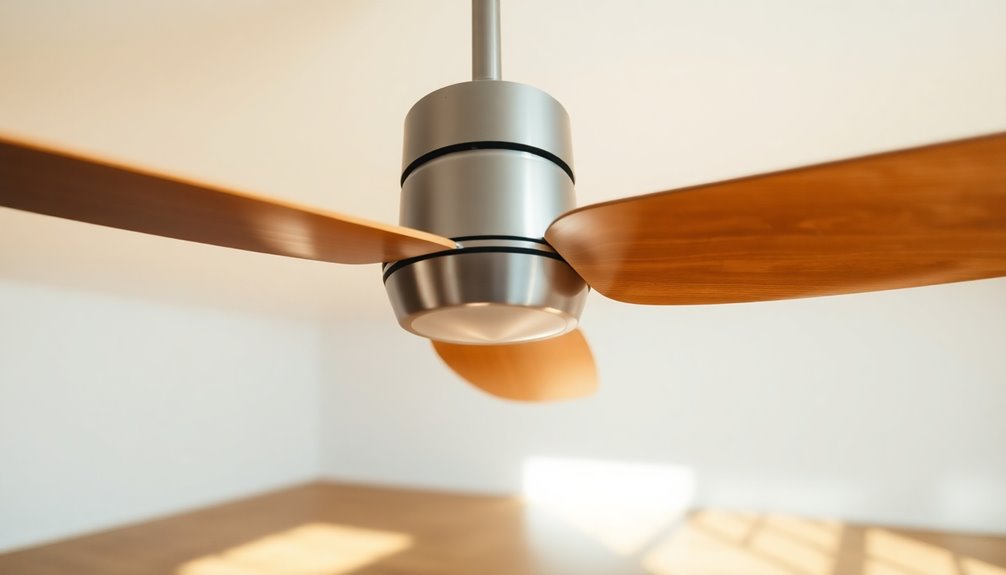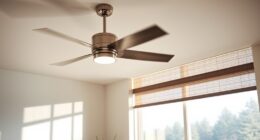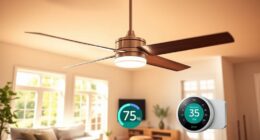Yes, ceiling fans do help your AC work better. They circulate air and create a wind chill effect, making you feel cooler without lowering the temperature. By using a fan, you can raise your thermostat by about 4°F and still feel comfortable, which eases the workload on your AC. This can lead to energy savings of up to 12% on cooling costs. Just remember to switch the fan direction seasonally for peak performance. If you're curious about maximizing your comfort and savings, there's plenty more to learn on enhancing your home's cooling system.
Key Takeaways
- Ceiling fans enhance AC performance by improving airflow distribution, allowing for higher thermostat settings without sacrificing comfort.
- They create a wind chill effect, making rooms feel cooler and reducing the strain on AC systems.
- Using ceiling fans can lower cooling costs by up to 12% when used in conjunction with air conditioning.
- Fans can reduce AC workload by 20-30%, extending the lifespan of the unit and minimizing maintenance costs.
- Proper fan direction adjustment maximizes cooling efficiency: counterclockwise in summer and clockwise in winter.
Function of Ceiling Fans

Ceiling fans play an essential role in enhancing indoor comfort by circulating air throughout a room. They help prevent stagnant air, which can make the space feel warmer than it is. By using a ceiling fan, you create a wind chill effect, making you feel cooler without actually lowering the room temperature. This is particularly beneficial during the summer months when you want to maintain a comfortable atmosphere. Additionally, many ceiling fans are designed with high CFM ratings for effective airflow, further improving the cooling effect. Furthermore, incorporating air purifiers into your indoor environment can significantly enhance the overall air quality, complementing the cooling effects of ceiling fans.
The direction of the fan's rotation is vital for seasonal comfort. In summer, set your ceiling fan to rotate counterclockwise to maximize cooling comfort. In winter, switch it to clockwise to help distribute warm air throughout the room. Commercial heat pumps can work in harmony with ceiling fans to enhance overall climate control in larger spaces. In addition, using a ceiling fan allows for reduced reliance on air conditioning, which can lead to increased energy efficiency in your home.
This versatility means you can use a ceiling fan year-round, enhancing your home's comfort while saving energy. Additionally, using ceiling fans in conjunction with heat pumps can further optimize energy efficiency and reduce costs in your home.
Ceiling fans use considerably less electricity than air conditioners, leading to notable energy savings. While they don't replace your air conditioner, they complement it by improving air circulation and reducing hot and cold spots. Their energy-efficient models can also help lower overall electricity costs.
Impact on AC Performance

Using ceiling fans greatly enhances the performance of your air conditioning system. By improving airflow, ceiling fans help distribute cool air more effectively, ensuring that every corner of your space stays comfortable.
This improved circulation allows you to raise your thermostat settings by up to 4°F without sacrificing comfort, leading to significant energy savings.
When you run a ceiling fan alongside your air conditioning unit, you can reduce the workload on your AC by 20-30%. This not only keeps your home cooler but also extends the lifespan of your air conditioning system, minimizing maintenance and repair costs.
Additionally, the wind chill effect created by ceiling fans can make a room feel cooler, allowing your AC to work less hard.
Moreover, ceiling fans assist in dehumidifying the air, which further enhances comfort levels. By reducing excess humidity, your air conditioning system can operate more efficiently, leading to a more pleasant indoor environment.
In short, combining ceiling fans with your air conditioning unit is a smart way to maximize performance, save energy, and create a comfortable living space.
Seasonal Fan Direction

Have you ever noticed how simply changing the direction of your fan can impact comfort levels in your home?
During the summer months, set your ceiling fan to rotate counterclockwise. This creates a cool downward draft, making you feel more comfortable while saving energy as your air conditioning works less.
In winter, flip the switch to clockwise. This pushes warm air down from the ceiling, helping to distribute heat evenly throughout the room.
If you forget to adjust the fan direction in winter, you might experience an unwanted wind chill effect, making your space feel colder than it really is.
The fan direction switch is usually located on the base of the fan, making it easy to make seasonal adjustments.
Energy Savings With Fans

Incorporating ceiling fans into your cooling strategy can lead to impressive energy savings. By simply using your ceiling fan, you can help you feel cooler without cranking up the air conditioning. In fact, you can raise the thermostat setting by approximately 4°F without a noticeable reduction in comfort. This adjustment can save on energy costs considerably.
When you run your ceiling fan blades in conjunction with your air conditioning, you can lower your cooling costs by up to 12%. With ceiling fans consuming about 70 watts of electricity compared to over 2000 watts for air conditioning units, you'll notice the difference in your utility bills.
Effectively using your ceiling fan can reduce your reliance on air conditioning by 20-30%, which adds up to substantial savings during the warmer months. Additionally, using ceiling fans can enhance your indoor air quality by improving humidity control and distributing conditioned air more evenly throughout your home.
If more households adopt this energy-efficient practice, we could see a collective nationwide reduction in cooling costs, saving billions of dollars.
Practical Usage Tips

To get the most out of your ceiling fans while cooling your home, it's important to use them effectively alongside your air conditioning. Start by using your ceiling fans in occupied spaces. This maximizes their cooling effect and helps your air conditioning system work more efficiently.
Don't forget to adjust your thermostat; raising it by 2-4°F can lower the temperature without sacrificing comfort, leading to significant energy savings.
Ensure that you turn the ceiling fan to rotate counterclockwise during the summer months. This direction promotes ideal airflow and keeps your space feeling cool. Remember, ceiling fans cool people, not spaces, so turn off your ceiling fan when leaving a room to conserve energy.
Regular cleaning is essential. Dust buildup can hinder your fan's performance, reducing its cooling effectiveness. By keeping your fans clean, you maintain maximum airflow efficiency.
Using a ceiling fan in conjunction with your central air conditioning system can enhance your comfort while lowering energy costs. By following these practical usage tips, you can create a more pleasant and cost-effective living environment.
Frequently Asked Questions
Should I Run a Ceiling Fan When AC Is On?
You should definitely run a ceiling fan when your AC is on. It creates a revitalizing wind chill effect, letting you raise the thermostat by about 4°F without losing comfort.
Plus, it helps distribute cooled air evenly, reducing those annoying hot and cold spots.
Using a fan together with your AC also lightens the load on your unit, potentially extending its lifespan.
With low operating costs, it's a smart move for efficiency.
Do Ceiling Fans Improve AC Efficiency?
Yes, ceiling fans can improve your AC efficiency.
When you use a ceiling fan, you create a cooling draft that makes your space feel more comfortable, allowing you to set your thermostat higher without sacrificing comfort.
This can reduce overall cooling costs and help maintain a consistent temperature throughout the room.
Plus, since ceiling fans use less energy than AC units, they're a cost-effective way to enhance your cooling system's performance.
Do Ceiling Fans Help With AC Bills?
You might think ceiling fans don't do much, but they can actually save you money on your AC bills.
By raising your thermostat setting by about 4°F, you can stay comfortable while using less energy. Operating a ceiling fan costs just about a cent per hour compared to the 36 cents for air conditioning.
Does a Ceiling Fan Reduce AC Cooling?
A ceiling fan doesn't directly reduce the cooling power of your air conditioning but enhances the overall comfort in your space.
By circulating air, it creates a wind chill effect, making you feel cooler without lowering the actual temperature.
This means you can set your thermostat a bit higher, which can lead to energy savings.
Conclusion
In the dance of summer heat, ceiling fans serve as your trusty partners, swirling cool air to embrace your space. By working in harmony with your AC, they create a revitalizing oasis, cutting energy costs while amplifying comfort. So, next time you flip that switch, remember: these spinning blades don't just circulate air; they elevate your entire cooling experience. Together, they transform sweltering days into a breezy retreat, turning your home into a sanctuary of relief.
